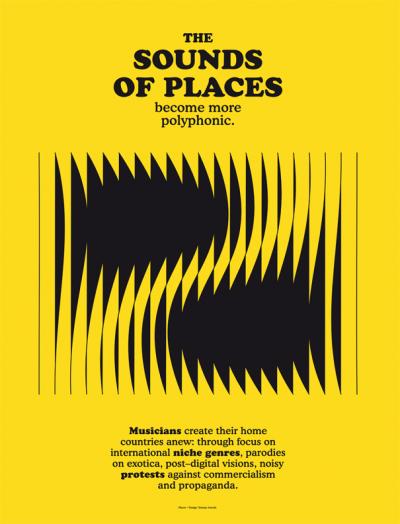
Music of Bombs and Bullets
Environmental sounds challenge Matthew Herbert more than a piano does. With noises of exploding bombs, collapsing buildings, and a dying pig he creates both abstract tracks and happy dance music. Manipulating noises is challenging, provocative, and still new territory, he argues. From the Norient book Seismographic Sounds (see and order here).
[Thomas Burkhalter]: In the liner notes of your 2015 album The Shakes you write that you work with bullets and shells bought on eBay. What exactly do you do with them?
[Matthew Herbert]: Most of them are from Iraq and Israel, many used on a battlefield. People picked them up to sell them on eBay. Beautifully executed pieces – thanks to our governments that spend so much money on arms. They sound like Tibetan prayer bells when you hit them. They are hollow, because they are missing the explosive part. It’s quite ironic.
[TB]: Why are war and violence the topic of so many of your projects?
[MH]: Death is a taboo. Considering how obsessed with war and violence our society is, it is very difficult to actually access recordings. For my album One Pig I became the farmer of a pig and I recorded its noises day and night. At the slaughterhouse, however, I was denied access to record its moment of death. The government has decided that we don’t have the right to see the full food chain. Likewise, trying to access sounds of war is tricky. For my album The End of Silence I received a recording from a war photographer who was being bombed in the war in Libya in 2011. His recording was incredibly disturbing because it was unmediated, not from TV.
[TB]: What exactly captured your interest?
[MH]: The End of Silence is a reflection on second-hand experience, distance, and about being far away. To me music is not about organizing sound only. Where a sound is from, how I got it, who recorded it with what microphone, is part of the story. My album Plat du Jour is centered on food. For the last track we recreated a dinner George Bush and Tony Blair held after they had started the war in Iraq. I had somebody bake the apple pie they had eaten. We set this apple pie up in a field near Manassas, the site of the first major battle of the American Civil War (1861), and we put a microphone next to it. An unwritten rule is to record close to the object in order to catch the pure sound without unwanted noises, but this doesn’t necessarily tell the story. If you are interested in the effects of violence, the microphone needs to be next to the person being shot. The microphone’s position is crucial. This would have been the last sound that person would have heard.
[TB]: Now you have the recorded sounds on your computer. What are your strategies in cutting and editing them?
[MH]: Well, this is a technical question. In reality it is difficult to separate editing from morality and politics. In fact, this difficulty is why I work with real sounds. Real sounds are constantly challenging me in a way a piano doesn’t. I don’t like to disguise samples too much, add loads of effects, or change pitch dramatically. If a sample starts sounding like a drum, then I feel I could have just used a drum. The original sound should retain some integrity. It’s a thin line, of course: by turning sounds into music they potentially lose some of it. I’m interested in slowing down time and examining every corner of a sound. In The End of Silence I used a six second sample and made forty minutes out of it. It felt like putting the sound on pause and then climbing in and walking around inside it. On this almost atomic level you find strange places. There were these two whistling sounds with pitch and I created something close to melody with human notes in anticipation of the bomb.
[TB]: How insecure are you when working with sounds that killed someone?
[MH]: Insecure is the wrong term. I do rigorous research in the material and I reflect on the concept a lot. But, yes, I definitely feel worried. The material is very powerful and I don’t want to create something disposable. We are used to seeing violence and explosions, but listening to it is still new. It feels very different, and I try to understand those differences. I ask people to listen more carefully and not to just let traumatic moments pass by without stopping and reflecting on them. If we only do things where we don’t know the consequences of our actions, we are doomed. We’re totally doomed.
[TB]: Are there ethical boundaries when working with sounds from war?
[MH]: I definitely think there are ethical boundaries. But I’m not sure where they are, and I guess that’s a part of my work: to find this out. A few years ago I recorded in a crematorium. Bodies are put inside a cremulator that slowly grinds bone fragments into fine powder. It’s the worst sound I’ve heard in my entire life. When I mixed the recording into a track to create a dark sound, I realized that this is not right. If someone close to me had died and a musician remixed it without asking permission, I wouldn’t be very pleased. When the Twin Towers collapsed I was there and recorded it. I did not use these recordings either; first I need a strong idea of how to do so. The recording from Libya is tough too. I don’t know who the people are who were killed during this explosion: civilians, doctors, pro-Gaddafi militiamen, Al-Qaeda? The End of Silence is a generalized memorial in a way. I want that moment to be remembered so that this explosion and these victims do not become yet another incident in some distant part of the world.
[TB]: This leads to so many questions. Is it always legitimate for someone to work with war samples? What is your intention and motivation? Might appropriating noises of war lead to self-promotion? How can we judge sound works today?
[MH]: You are right. Editing and manipulating sound is still new territory. We are still trying to find the right language to talk about it. Is it okay for children to hear the sound of two adults fucking? We’re so naïve with sound. It’s a revolution that’s happened and nobody talks about it. Anything is possible. Sound can document events. Or we musicians can play with these documents. Digital samplers allow us to play the sound of ten thousand bombs exploding at the same time. It’s a profound shift in the relationship between music, the producer, the listener, and the world.
[TB]: With today’s music software you could produce happy dance music out of manipulated noises from war. You could trick listeners.
[MH]: Well, you’ll be the first person I tell: I’ve actually done that with the album Meaningless under the pseudonym DJ Empty. I made dance music out of bombs, shells, and bullets. I wanted to see if people would just dance to anything. What impact would it have? Would anyone make inquiries? Nobody gave a shit. Nobody knew DJ Empty and we didn’t tell anybody. I’ve tried various experiments like that. People don’t care. Well, I shouldn’t say that. People are used to everything being explained to them. Critical faculty has evaporated.
[TB]: Is it possible to recognize if you listen carefully?
[MH]: If you served in the army you’d know what these sounds were. If you were just an eighteen-year-old kid, you wouldn’t. It’s not a happy record. It is about the gruesome links between music technology and military history. Amplification, compression, much was developed for transmitting quiet noises over long distances.
[TB]: Promotional material for your albums is often rich with details about concepts and content. You suggest that it is important to give credit to the samples one is using, but maybe you hide things, too, or do not tell the truth?
[MH]: It’s definitely part of the trick to include where samples are from in promo texts. But I only say things if I think it’s important. And, yes, everything I say is not necessarily true. Sometimes things are taken at face value and I think it is our role as artists to create work that not only challenges us but also challenges the context that it exists in. Some people are obsessed with the question of what reaction they are supposed to have to my music. I’ve one hundred answers to that. One would be that music doesn’t exist in a vacuum. It doesn’t just appear out of the air. It comes out of speakers. Someone’s chosen to put it on. Do you hear it in a shop or on the radio? Did somebody recommend it to you? What’s the title of the song? What does the artwork tell? Music is part of society. It doesn’t exist in a bubble.
[TB]: So maybe it was not a bomb in Libya that was the key sample in The End of Silence?
[MH]: Well, that’s interesting because I trust that the file war photographer Sebastian Meyer sent me was from Libya. He had a photograph to prove it. And the recording was an hour long, out of which I took just a small excerpt. So I heard a lot of context, too. But, yes, I trust him and you are trusting me.
[TB]: So let’s trust each other then. It’s probably easiest to live with.
[MH]: Or a disaster. Some Americans trust Fox News to tell them the truth.
The Podcast
Interview: Thomas Burkhalter
Production: Theresa Beyer
The interview was conducted via Skype on 6.5.2015. This text was published first in the second Norient book «Seismographic Sounds».
Biography
Shop

Published on March 02, 2016
Last updated on July 14, 2020
Topics
What happens when U.S.-blogger collects african music and offers it for free? What is the difference between «textually signaled» and «textually unsignaled»?
Sampling is political: about the use of chicken clucks or bomb sounds in current music.
How does the artits’ relationship to the gear affect music? How to make the climate change audible?
How does Syrian death metal sound in the midst of the civil war? Where is the border between political aesthetization and inappropriate exploitation of death?


